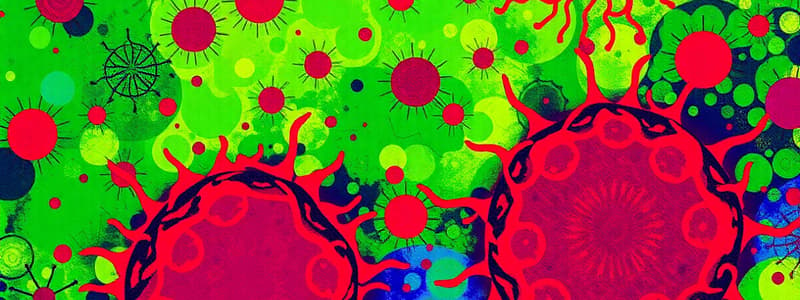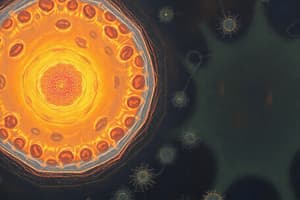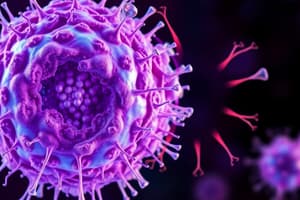Podcast
Questions and Answers
Which of the following is a key feature of prokaryotic cells?
Which of the following is a key feature of prokaryotic cells?
- Have organelles
- Contain a nucleus
- Complex structure
- DNA is free in the cytoplasm (correct)
Plant cells contain mitochondria but lack chloroplasts.
Plant cells contain mitochondria but lack chloroplasts.
False (B)
What is cell differentiation?
What is cell differentiation?
The process where cells develop specific features to perform their function.
The formula for magnification is Magnification = Image size ÷ ______.
The formula for magnification is Magnification = Image size ÷ ______.
Match the following structures with their descriptions:
Match the following structures with their descriptions:
What is the main role of mitosis?
What is the main role of mitosis?
Mitosis involves stages such as prophase, metaphase, anaphase, and cytokinesis.
Mitosis involves stages such as prophase, metaphase, anaphase, and cytokinesis.
Give one example of a specialized cell and its adaptation.
Give one example of a specialized cell and its adaptation.
Flashcards
Eukaryotic cell
Eukaryotic cell
A complex cell with a nucleus and membrane-bound organelles, found in animals, plants, fungi, and protists.
Prokaryotic cell
Prokaryotic cell
A simple cell without a nucleus and other membrane-bound organelles. Their DNA is located in the cytoplasm. Bacteria are examples.
Cell specialisation
Cell specialisation
The adaptation of a cell to perform a specific function. This can be due to changes in size, shape, or number of organelles.
Stem cell
Stem cell
Signup and view all the flashcards
Mitosis
Mitosis
Signup and view all the flashcards
Magnification
Magnification
Signup and view all the flashcards
Cell cycle
Cell cycle
Signup and view all the flashcards
What are the differences between light and electron microscopes?
What are the differences between light and electron microscopes?
Signup and view all the flashcards
Electrolysis
Electrolysis
Signup and view all the flashcards
Electrolyte
Electrolyte
Signup and view all the flashcards
Electrolysis of Molten Compounds
Electrolysis of Molten Compounds
Signup and view all the flashcards
Electrolysis for Metal Extraction
Electrolysis for Metal Extraction
Signup and view all the flashcards
Electrolysis of Solutions
Electrolysis of Solutions
Signup and view all the flashcards
Half Equation for Reduction
Half Equation for Reduction
Signup and view all the flashcards
Half Equation for Oxidation
Half Equation for Oxidation
Signup and view all the flashcards
Electric Current
Electric Current
Signup and view all the flashcards
Resistance
Resistance
Signup and view all the flashcards
Potential Difference
Potential Difference
Signup and view all the flashcards
Embryonic Stem Cells
Embryonic Stem Cells
Signup and view all the flashcards
Adult Stem Cells
Adult Stem Cells
Signup and view all the flashcards
Diffusion
Diffusion
Signup and view all the flashcards
Active Transport
Active Transport
Signup and view all the flashcards
Photosynthesis
Photosynthesis
Signup and view all the flashcards
Word Equation for Photosynthesis
Word Equation for Photosynthesis
Signup and view all the flashcards
Symbol Equation for Photosynthesis
Symbol Equation for Photosynthesis
Signup and view all the flashcards
Where does photosynthesis occur?
Where does photosynthesis occur?
Signup and view all the flashcards
Limiting Factor in Photosynthesis
Limiting Factor in Photosynthesis
Signup and view all the flashcards
Respiration
Respiration
Signup and view all the flashcards
Aerobic Respiration Equation
Aerobic Respiration Equation
Signup and view all the flashcards
Anaerobic Respiration
Anaerobic Respiration
Signup and view all the flashcards
Oxygen Debt
Oxygen Debt
Signup and view all the flashcards
Metabolism
Metabolism
Signup and view all the flashcards
Study Notes
Cell Biology
-
Eukaryotes vs. Prokaryotes: Eukaryotic cells are complex, containing a nucleus and organelles, while prokaryotic cells are simpler, lacking a nucleus and organelles; DNA is free in the cytoplasm. Prokaryotes have plasmids, a cell wall, and smaller ribosomes.
-
Animal vs. Plant Cells: Common structures include nucleus, cytoplasm, cell membrane, mitochondria, and ribosomes. Plant cells uniquely have a cell wall, chloroplasts, and a large permanent vacuole.
-
Cell Specialization: Cells adapt specific features to perform a particular function. Examples include: sperm cells (tail for swimming, mitochondria for energy), nerve cells (long axon for signal transmission), and root hair cells (large surface area for water and mineral absorption).
-
Cell Differentiation: Cells develop specific features to perform their function, primarily in early animal development and throughout plant life.
-
Microscopy: Magnification is the enlargement of an image relative to the object (Magnification = Image size ÷ Real size). Light microscopes have lower resolution and magnification, allowing observation of living specimens, while electron microscopes offer higher resolution and magnification but can only view non-living samples.
-
Cell Division: Mitosis is a process of cell division responsible for growth, repair, and asexual reproduction. The cell cycle includes DNA replication, mitosis (prophase, metaphase, anaphase, telophase), and cytokinesis (cytoplasm division).
-
Stem Cells: Undifferentiated cells that can divide and differentiate into specialized cells. Embryonic stem cells are pluripotent (can differentiate into any cell type), while adult stem cells are multipotent (limited to certain cell types).
-
Cell Transport:
-
Diffusion: Movement of particles from a high to low concentration (e.g., oxygen diffuses into cells).
-
Osmosis: Movement of water from a dilute solution to a concentrated solution through a semi-permeable membrane (e.g., water into plant roots).
-
Active Transport: Movement of substances against a concentration gradient using energy (e.g., mineral ions absorbed by root hair cells).
Bioenergetics
-
Photosynthesis: Plants convert light energy into chemical energy stored in glucose (6CO₂ + 6H₂O → C₆H₁₂O₆ + 6O₂). This occurs in chloroplasts containing chlorophyll.
-
Photosynthesis Factors: Photosynthesis rate depends on light intensity, carbon dioxide concentration, and temperature. A limiting factor limits the rate of the process, like the availability of light, CO₂ or temperature. Enzymes speed up reactions, but denature at high temperatures.
-
Photosynthesis Glucose Uses: Glucose made in photosynthesis is used for respiration, stored as starch, converted into cellulose (cell walls), combined with nitrates (proteins) and/or converted to fats/oils.
-
Respiration: The process of breaking down glucose to release energy. Aerobic respiration (C₆H₁₂O₆ + 6O₂ → 6CO₂ + 6H₂O + energy) requires oxygen, while anaerobic respiration (different products depending on the organism) does not.
-
Exercise Response: Exercise leads to increased heart rate for faster oxygen transport; increased breathing for more oxygen; anaerobic respiration, lactic acid buildup, and oxygen debt if oxygen demand exceeds supply.
-
Metabolism: The sum of all chemical reactions in an organism, including the conversion of glucose, formation of lipids, and breakdown of excess proteins.
Atomic Structure
-
Atoms, Elements, and Compounds: Atoms are the smallest unit of an element, retaining chemical properties. Elements are pure substances of only one atom type. Compounds are formed from multiple elements chemically combined in fixed proportions.
-
Mixtures: Mixtures are combinations of substances without chemical bonds, separated by physical methods (e.g., filtration, distillation, crystallisation, chromatography).
-
Atomic Theory Development: Key discoveries include Dalton's indivisible spheres, Thomson's “plum pudding” model (electrons within a positive sphere), Rutherford's nucleus, and Bohr's electron shells.
-
Subatomic Particle Charges: Protons (+1), neutrons (0), and electrons (-1) carry these charges.
-
Atom Size and Mass: Atoms are approximately 0.1 nanometers in size and subatomic particles vary in mass; protons (1), neutrons (1), electrons (approximately 1/2000).
-
Relative Atomic Mass: Relative atomic mass (Ar) is the weighted average mass of isotopes of an element compared to 1/12th the mass of a carbon-12 atom.
Chemical Changes
-
Acids with Metals: Acids react with metals to produce a salt and hydrogen gas (Acid + Metal → Salt + Hydrogen). Salts formed from different acids have different names (e.g., chlorides, sulfates, nitrates).
-
Neutralization: The reaction between an acid and a base to produce a salt and water (Acid + Base → Salt + Water).
-
Soluble Salts: Soluble salts are made by reacting an acid with a suitable base, carbonate, or metal, then filtering and evaporating the solution.
-
pH Scale: The pH scale measures the concentration of hydrogen ions (H⁺); acids have pH below 7, neutral solutions are 7, and alkalis have a pH above 7.
-
Strong and Weak Acids: Strong acids fully ionise in water (hydrochloric), weak acids only partially ionise (e.g., ethanoic).
-
Electrolysis: Using electricity to break down a substance; electrolytes are electrically conductive liquids containing ions.
-
Electrolysis of Molten Compounds: Positive ions move to the cathode (reduction) and negative ions to the anode (oxidation).
-
Electrolysis for Metal Extraction: More reactive metals like aluminum are extracted from ores via electrolysis of molten compounds.
Electricity
-
Circuit Symbols: Symbols represent circuit components in diagrams (e.g., cell, resistor, lamp).
-
Electric Charge and Current: Electric charge (measured in coulombs (C)) causes force in an electric field. Current (measured in amperes (A)) is the flow of electric charge (Current = Charge ÷ Time).
-
Current, Resistance, and Potential Difference: Resistance (ohms (Ω)) opposes current flow, potential difference (volts (V)) is energy transferred per unit charge. Ohm's Law: Voltage = Current x Resistance.
-
Resistors: Fixed resistors have constant resistance, variable resistors can be adjusted (e.g., dimmer switch). Thermistors' resistance decreases with temperature; LDR's decrease with light intensity.
-
Series vs. Parallel Circuits: Series circuits have the same current throughout, shared potential difference; parallel circuits have split current, same potential difference across branches.
-
Domestic Uses and Safety: Plugs contain live (brown), neutral (blue), and earth (green/yellow) wires; circuit breakers prevent overheating/fires due to high current.
-
Mains Electricity: UK mains electricity is 230V, 50Hz.
-
Power: Power (watts (W)) is calculated as Voltage x Current.
-
Energy Transfer: Energy transferred (joules (J)) = Power x Time.
-
National Grid: Distributes electricity; step-up and step-down transformers regulate voltage to reduce transmission losses.
Studying That Suits You
Use AI to generate personalized quizzes and flashcards to suit your learning preferences.




